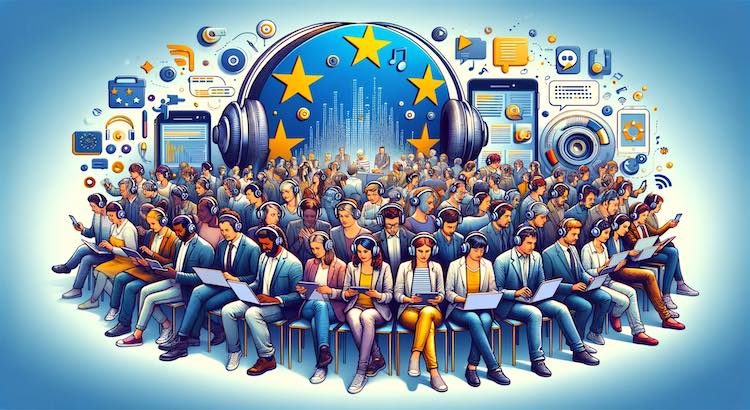Making Interactive Audio Content Accessible: How the EU WCAG 2025 Changes the Game
Interactive audio content is everywhere. From podcasts and audio guides to dynamic lessons and storytelling, creators reach audiences worldwide using audio. As technology expands, so do expectations for equal digital access. The upcoming European Union Web Content Accessibility Guidelines (WCAG) 2025 will set a new gold standard for accessibility. Meeting these guidelines ensures everyone, including people with disabilities, can navigate and benefit from your content.
Why Accessibility Matters in Interactive Audio
Accessibility is not just a trend—it’s essential for modern digital content. The WCAG 2025 standards raise the bar and require all digital content to be available for everyone.
Benefits of Accessible Audio Content
- Reaches users who are deaf or hard of hearing
- Benefits users in quiet zones or those who cannot use headphones
- Helps people who prefer reading or have language processing challenges
- Makes searching and quoting content easier
- Increases audience size and improves reputation
According to the World Health Organization, over 1.5 billion people globally live with some hearing loss (2021). Accessibility inclusivity is an ethical, legal, and practical requirement.
What Does the EU WCAG 2025 Require for Audio?
The EU WCAG 2025 guidelines call for digital content to be “perceivable, operable, understandable, and robust.” For audio creators, this means:
- Every spoken word must have an accurate text version
- Interactive elements must be simple to use for people with disabilities
- Transcriptions should reflect all speakers and key sounds
- Text alternatives must be clear, readable, and easy to navigate
Failing to meet these standards can result in legal and financial risks (European Accessibility Act, 2022).
Types of Audio Content That Require Accessible Transcripts
- Podcasts
- Audio tours and guides
- Interactive stories and e-learning modules
- Webinars and live audio events
- Corporate training voice-overs
- Social media audio (e.g., Twitter Spaces, Clubhouse)
Who Benefits?
- Users with hearing disabilities
- People with limited access to sound devices
- Those in noisy or shared environments
- Anyone learning a new language
Human vs. Automated Transcription: What’s the Difference?
You can transcribe audio using automation or human experts. Automated transcription has improved, but it still struggles with complex scenarios.
Where Automated Tools Fall Short
- Heavy accents or multiple speakers
- Background noise and cross-talk
- Technical language or industry jargon
- Emotional tones and subtle speech
A study found that average AI-powered transcription error rates can reach 12% to 22%, while human transcribers may achieve as low as 4% (Stanford, 2021).
Why Human Transcription Prevails
- Handles complex audio, accents, and multiple speakers
- Captures tone, intent, and nuance
- Produces transcripts that are easy to read and follow
- Ensures proper formatting for accessibility
For best results, consider trusted human transcription services that meet strict accuracy standards.
How to Make Interactive Audio Content WCAG 2025 Compliant
To align with the WCAG 2025, follow these steps:
- Transcribe Every Audio File: Ensure your audio has a text alternative reflecting all speakers and essential non-speech sounds.
Transcription services like GoTranscript can help. - Provide Closed Captions: For videos or audio-visual content, include accurate closed caption services that display dialogue and significant sounds.
- Use Subtitles for Multilingual Content: Make content accessible in more than one language by adding subtitling services.
- Review and Proofread: Hire transcription proofreading services to eliminate mistakes and jargon that harm accessibility.
- Choose the Right Format: Offer transcripts in plain text or structured HTML to support screen readers and assistive technology.
For more automated tasks, some creators use automated transcription and review the output with human editors for compliance.
Expanding Accessible Content Globally: Translation and Localization
Many audio projects serve international users. Make content even more inclusive by using text translation and audio translation services.
- Reach speakers of multiple languages
- Follow local accessibility laws
- Enhance user engagement across markets
Cost Considerations for Accessibility
Worried about the price? Transcription pricing and captioning services pricing have become more affordable in recent years (NAB, 2023). Accessible content is an investment, not just a cost—it brings more visitors and improves compliance.
Easy Ways to Start
- Order transcription directly with a secure uploader
- Try an AI transcription subscription for frequent projects
- Order captions to add to videos or live streams
Conclusion: GoTranscript Makes Accessibility Simple
Interactive audio content must be accessible to all to meet the new EU WCAG 2025 requirements. The right solution starts with accurate, clear, human-driven transcription. GoTranscript offers proven, secure transcription services and accessibility tools for every industry. Their global team ensures your audio, captions, and translations are clear and compliant. Stay ahead of evolving rules and reach every listener—choose GoTranscript to make your content truly inclusive.



















 Verified Order
Verified Order